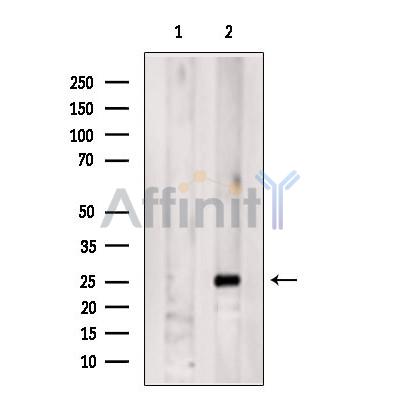APCS Antibody - #DF6742
| Product: | APCS Antibody |
| Catalog: | DF6742 |
| Description: | Rabbit polyclonal antibody to APCS |
| Application: | WB IHC |
| Reactivity: | Human, Mouse, Rat |
| Prediction: | Rabbit |
| Mol.Wt.: | 25kDa; 25kD(Calculated). |
| Uniprot: | P02743 |
| RRID: | AB_2838704 |
Related Downloads
Protocols
Product Info
*The optimal dilutions should be determined by the end user. For optimal experimental results, antibody reuse is not recommended.
*Tips:
WB: For western blot detection of denatured protein samples. IHC: For immunohistochemical detection of paraffin sections (IHC-p) or frozen sections (IHC-f) of tissue samples. IF/ICC: For immunofluorescence detection of cell samples. ELISA(peptide): For ELISA detection of antigenic peptide.
Cite Format: Affinity Biosciences Cat# DF6742, RRID:AB_2838704.
Fold/Unfold
9.5S alpha 1 glycoprotein; 9.5S alpha-1-glycoprotein; Amyloid P component serum; APCS; MGC88159; Pentaxin related; Pentraxin 2; PTX 2; PTX2; SAMP_HUMAN; SAP; Serum amyloid P component; Serum amyloid P-component(1-203);
Immunogens
A synthesized peptide derived from human APCS, corresponding to a region within the internal amino acids.
- P02743 SAMP_HUMAN:
- Protein BLAST With
- NCBI/
- ExPASy/
- Uniprot
MNKPLLWISVLTSLLEAFAHTDLSGKVFVFPRESVTDHVNLITPLEKPLQNFTLCFRAYSDLSRAYSLFSYNTQGRDNELLVYKERVGEYSLYIGRHKVTSKVIEKFPAPVHICVSWESSSGIAEFWINGTPLVKKGLRQGYFVEAQPKIVLGQEQDSYGGKFDRSQSFVGEIGDLYMWDSVLPPENILSAYQGTPLPANILDWQALNYEIRGYVIIKPLVWV
Predictions
Score>80(red) has high confidence and is suggested to be used for WB detection. *The prediction model is mainly based on the alignment of immunogen sequences, the results are for reference only, not as the basis of quality assurance.
High(score>80) Medium(80>score>50) Low(score<50) No confidence
Research Backgrounds
Can interact with DNA and histones and may scavenge nuclear material released from damaged circulating cells. May also function as a calcium-dependent lectin.
N-glycosylated with a complex biantennary oligosaccharide chain with a sialic acid at the end (disialo-SAP). Monosialo-SAP as well as asioalo-SAP are also detected.
Secreted.
Found in serum and urine.
Belongs to the pentraxin family.
Restrictive clause
Affinity Biosciences tests all products strictly. Citations are provided as a resource for additional applications that have not been validated by Affinity Biosciences. Please choose the appropriate format for each application and consult Materials and Methods sections for additional details about the use of any product in these publications.
For Research Use Only.
Not for use in diagnostic or therapeutic procedures. Not for resale. Not for distribution without written consent. Affinity Biosciences will not be held responsible for patent infringement or other violations that may occur with the use of our products. Affinity Biosciences, Affinity Biosciences Logo and all other trademarks are the property of Affinity Biosciences LTD.
